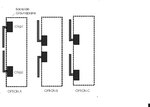biff44
Advanced Member level 6
- Joined
- Dec 24, 2004
- Messages
- 5,048
- Helped
- 1,376
- Reputation
- 2,748
- Reaction score
- 1,056
- Trophy points
- 1,393
- Location
- New England, USA
- Activity points
- 37,917
I thought I knew this stuff, but started to have some doubts. I have two receiver chips, and am going to attach a quarterwave monopole to each, in hopes of attaining some spatial diversity. 915 Mhz. I was going to use configuration A. My thinking was that the antenna phase center is where the monopole whip meets the ground plane, so configuration A gets the antenna phase centers the farthest apart. But then I looked at the antenna ends almost touching, and started to doubt my logic.
Which antenna orientation, printed on the same board area, would give me the greatest spatial diversity: A, B, or C? And why?
Which antenna orientation, printed on the same board area, would give me the greatest spatial diversity: A, B, or C? And why?
